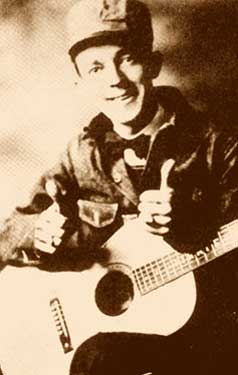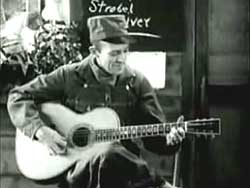 The original Jimmy Rodgers' one & only film appearance was in the short subject The Singing Brakeman (1929).
The original Jimmy Rodgers' one & only film appearance was in the short subject The Singing Brakeman (1929).
He's wearing a train worker's outfit (really only a costume), seated on a porch near an elderly woman in her own chair knitting. Another elderly woman is doing the dishes inside, visible from the window & when she through the screen door. It's quite a natural-seeming setting, but is of course completely a sound stage.
He sings "Waiting for the Train" first, then the old lady puts her head out the window & asks Jimmy if he ever thinks of his dad. This sets him to singing "Daddy & Home," a song of deep nostalgia with a bit of Jimmy's famous yodelling.
Saving the best for last, he sings his country blues classic "T for Texas" aka "Blue Yodel No. 1" which Jimmy calls "an old yodel song."
This down-home front-porch performance may be trumped up a couple character actresses fussing & knitting, but Jimmy comes off as authentic, songs with innocence & simplicity & surprising beauty.
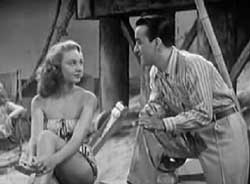 Emile Petti & His Orchestra back up Del Casino (who usually has his own orchestra) crooning the title number Surrender (1946) to Jeni Freeland. This was recorded much earlier than 1946, but not released until then.
Emile Petti & His Orchestra back up Del Casino (who usually has his own orchestra) crooning the title number Surrender (1946) to Jeni Freeland. This was recorded much earlier than 1946, but not released until then.
The stage is tricked out like a sandy beach by a pier, on which there is a club or cafe open to the seaside, the orchestra being in there while Del sings just outside.
The love song is a classic but not one of my favorites, it just seems like a commercial big-band number of the day: "I'll bring you/ A love you can cling to/ A love that won't be untrue/ So please be tender/ And darling surrender/ And love me as I love you."
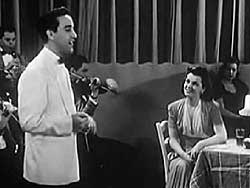 Opening on a dance floor in a nightclub, we're listening to Del Casino & His Orchestra in One Look at You (1943).
Opening on a dance floor in a nightclub, we're listening to Del Casino & His Orchestra in One Look at You (1943).
Del in a white jacket stops conducting, turns to face the audience, & begins to sing the three-minute soundie's title song: "One look at you, one look at you/ And then I knew I had to love you."
The crooner performance is a little too generic to be thrilling, but the director gussied up the visuals by having a photograph album leafed through, settling first on a picture of the girl Del presumedly is singing about.
The photo comes to life, showing the girl seated in a garden fixing a hat. It's the one-name actress "Tamara." The page is flipped, with another moving photograph, then a third living photo of the gal in a cocktail lounge acting kind of sleezy at the camera when she realizes she's come to life in the picture, plus other living photos including lighting up a cigarette while skiing.
The song ends with Del holding the girl's hand, as she is sitting up front at a nightclub table: "Oh darling I could write a book/ Each time I look at you."
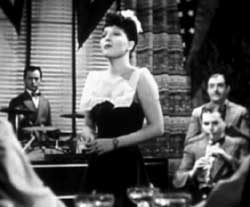 Del Casino & His Orchestra are backed up by one-name vocalist Tamara in It All Comes Back to Me Now (1941). Del Casino & His Orchestra are backed up by one-name vocalist Tamara in It All Comes Back to Me Now (1941).
The song was the only hit Del Casino ever had. The one-name singer, a musical stage actress of the 1930s, has an exoticism about her.
She's a fine singer, with just a bit of upper class haughtiness that fits the staged setting in a yacht club. The scene cuts to the deck of a yacht, with Tamara held from behind in the arms of Del, who is uncommonoy handsome. The scene cuts back to the club & Del sings the next verse. They finish the number as a duet.
It was included in the Castle Films one-reel home movie Songs of Love (1945) together with In Love with a Song (1941) featuring tenor Gene Grounds, backed by Bobby Sherman & His Orchestra, with a dance routine by Charles Brown & Joan Blair & Isn't That Just Like Love (1941) featuring lead vocal from former child star Sylvia Froos, backed by Dave Schooler & His Twenty-one Swinghearts.
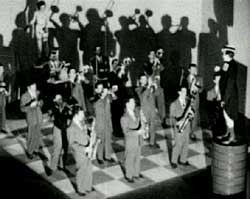 That latter number, Isn't That Just Like Love, had recently been a Glenn Miller hit, but the first soundies lacked the budget for talent like that, so this version has vocalist Sylvia Froos, a former child star. It's not the best of luck to have been backed up by the fairly awful Dave Schooler & His Twenty-one Swinghearts. That latter number, Isn't That Just Like Love, had recently been a Glenn Miller hit, but the first soundies lacked the budget for talent like that, so this version has vocalist Sylvia Froos, a former child star. It's not the best of luck to have been backed up by the fairly awful Dave Schooler & His Twenty-one Swinghearts.
Sylvia Froos introduces her song as "You Never Know" which I suppose could be an alternate title for the song she sings Isn't That Just Like Love (1941), but really seems like just one more mistake in this sloppily done wee film.
She performs this number in a voice that is like a lesser version of belt-it-out Ethel Merman, which is not how Sylvia always sounded. The lyrics begin:
"Calm is the night; the wind is asleep/ A drowsy old moon walks above/ Suddenly comes a jolt/ Crash goes a thunder bolt/ Isn't that just like love?"
Her back-up band is arrayed behind her & they're cute as a box of buttons. Most of the "all girl" bandsof the '30s & '40s were frankly better than average musicians. But in the present case, these Twenty-one Swinghearts do hit a few sour notes. So it can't have been easy for these gals to overcome the popular sentiment that girl-bands were for novelty only.
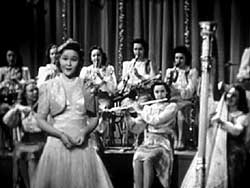 An amusingly bizarre soundie features Charlie Spivak & His Orchestra. Hop, Skip & Jump (1942), the band is hanging out in what appears to be a cafe where the waitresses wear bellhop hats.
An amusingly bizarre soundie features Charlie Spivak & His Orchestra. Hop, Skip & Jump (1942), the band is hanging out in what appears to be a cafe where the waitresses wear bellhop hats.
A girl & one of the bandmates are playing checkers on a table, with the trumpeter seated nearby watching intently. Another bandmate is playing another girl at the next table, but Charlie Spivak is bored with watching, or perhaps only tired, & nods off to sleep.
He goes into a surreal dream in which he is standing on a stack of checkers conducting the band which is arrayed in the squares of a checkerboard playing the title song Hop, Skip & Jump.
One of the waitresses from the earlier scene, now in bathing suit, is on the opposite side of the board conducting from another stack of checkers, periodically claiming the attention of the whole band which whirls around to follow her conducting instead of Charlie's.
Charlie by the way is absurdly dressed. It's a totally off-the-wall little film with a decent instrumental to back up its creativeness. There are some very funny bits imbedded in the thing, like the miniature drum kit strapped to the drummer, the miniature piano tied to the pianist, & Charley's idiotic smile & baggy tux.
Eventually there are a few lyrics which the band shouts out: "It's a killer Charlie/ Everybody swing your partner round the floor..." nothing special. But all of a sudden the orchestra has vanished, & chorus girls are dancing in the checkerboard squares while Charley is sitting on his stack of checkers appreciating the dancing.
At length Charlie comes down from his checker stack, & his rival conductor comes down off hers, & about then Charlie wakes up in the cafe.
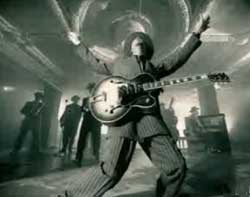 The remarkable swing revival band Big Band Voodoo Daddy seamlessly mixes a style from the 1930s or 40s with modern goth, with zoot suited zombies & vampires in the black & white music video Mr. Pinstripe Suit (1998).
The remarkable swing revival band Big Band Voodoo Daddy seamlessly mixes a style from the 1930s or 40s with modern goth, with zoot suited zombies & vampires in the black & white music video Mr. Pinstripe Suit (1998).
Lead singer Scott Morris is obviously influenced by Cab Calloway, right down to referencing "Hi De Ho" in the lyrics. The fact that he's playing an electric guitar in no way undermines the retro jive.
The brass in the band predominates so it has a big-band sound & a jump-blues or hot-jazz sound overall, with wonderful odd lyrics about Mr. Pinstripe Suit, the modern Smoky Joe:
"Well now friends le me tell you about this cat that I once met/ Smooth talker with an export cigarette/ I don't believe I ever saw him without a cocktail in his hand/ And no one swings as hard to the big bad voodoo band."
The fact that some absolutely gorgeous gals with a Ziegfield Follies look to them doesn't hurt the absolute wonder of the music video.
These guys can play ragtime or just about any 1930s or '40s hot & hopping swing. When I listened to some of their live concert numbers it was only a tiny bit disappointing that they're not quite as perfect-a-mento as the video that has the sound cleaned up. I am otherwise awed & appreciative that this group is giving genuinely great music from out of the past to a brand new generation.
copyright © by Paghat the Ratgirl
|
